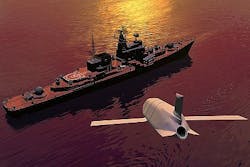Lockheed Martin moves closer to demonstrating Long Range Anti-Ship Missile (LRASM)
ARLINGTON, Va., 21 March 2013. Missile designers at the Lockheed Martin Corp. Missiles and Fire Control sector in Orlando, Fla., are moving closer to demonstrating surface launch of a new-generation long-range anti-ship missile with a $54.4 million contract modification announced Wednesday from the U.S. Defense Advanced Research Projects Agency (DARPA) in Arlington, Va.
The contract calls for Lockheed Martin to conduct additional surface-launch risk-reduction work prior to two planned flight demonstrations of the Long Range Anti-Ship Missile (LRASM) to attack enemy surface vessels at standoff ranges.
LRASM is a joint program of DARPA and the U.S. Office of Naval Research in Arlington, Va., to develop and demonstrate standoff anti-ship strike weapon technologies. In upcoming LRASM surface-launch tests, Lockheed Martin will fire a LRASM prototype from a Navy Vertical Launching System (VLS) canister.
The new anti-ship missile and its missile electronics will provide Navy warships like the guided missile cruiser with the ability to attack important enemy ships outside the ranges of the enemy's ability to respond with anti-ship missiles of its own.
The LRASM concept seeks to reduce dependence on precision intelligence, surveillance, and reconnaissance sources, data links, and GPS satellite navigation and guidance by demonstrating advanced onboard missile sensor and missile processing capabilities, which will enable precision engagement of moving ships based only on course and initial target cueing in the presence of electronic jamming and other enemy missile countermeasures.
LRASM will be compatible with the Navy Vertical Launch System and will have sufficient range to engage targets from well beyond enemy direct counter-fire ranges. The missile also will be able to penetrate advanced air defenses. If the LRASM program yields a new deployable anti-ship missile, it would replace front-line U.S. anti-ship weapon systems such as the Boeing AGM-84 Harpoon missile.
Two divisions of Lockheed Martin initially won separate $10 million study contracts from DARPA in summer 2009 to start designing LRASM and its missile guidance systems. Working on the program were segments of Lockheed Martin Missiles and Fire Control in Grand Prairie, Texas, and Orlando, Fla.
In late 2010 Lockheed Martin won a $157.7 million DARPA contract to demonstrate a LRASM ship-launched, stand-off anti-ship strike weapon able to destroy enemy warships and other maritime surface targets at significant stand-off ranges.
The program, which is in the second of two phases, initially had Lockheed Martin working on technology for two variants, the LRASM-A in Orlando, Fla., and LRASM-B in Grand Prairie, Texas. The LRASM-A was to capitalize on the Joint Air to Surface Standoff Missile Extended Range (JASSM-ER) airframe and incorporate additional sensors and systems to achieve a stealthy and survivable subsonic cruise missile.
The LRASM-B portion had focused on operating at the other end of the spectrum for precision strike weapons attacking from high-altitude and supersonic speed with stealthy penetration. Early last year DARPA abandoned work on LRASM-B to focus only on the LRASM-A project to reduce risks and speed delivery of LRASM technology to the Navy.
DARPA began captive carry flight tests of LRASM sensors aboard a research business jet in May 2012 to demonstrate elements of the integrated sensor suite. The agency originally had scheduled two air-launched LRASM flight demonstrations for early this year.
Just this month DARPA increased the scope of the air-launched LRASM program to include a third flight. Captive carry events will continue over the next several months, with the first live-fire exercise set for this summer.
DARPA also is integrating a LRASM prototype to launch from a surface vessel by modifying the missile airframe, designing the booster separation system, and fabricating a hybrid canister to accommodate the LRASM. Two ballistic test surface launches are planned for late next year.
Lockheed Martin is in charge of LRASM overall development, and the BAE Systems Electronic Systems segment in Nashua, N.H., is developing the LRASM onboard sensor systems.
On the LRASM contract awarded this week, Lockheed Martin will do the work in Orlando, Fla.; Baltimore; and Walled Lake, Mich., and should be finished by late next year.
For more information contact Lockheed Martin Missiles and Fire Control online at www.lockheedmartin.com/us/mfc, DARPA at www.darpa.mil, or the Office of Naval Research at www.onr.navy.mil.
